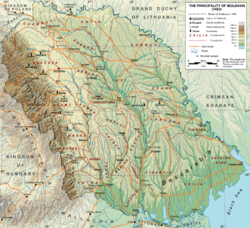- Moldavia
-
This article is about the medieval principality. For the modern state, see Moldova. For other uses, see Moldova (disambiguation).
Principality of Moldavia
Moldova (Ţara Moldovei) (ro)Vassal of the Ottoman Empire (1514-1859) 1346–1859  →
→
 →
→
 →
→

Flag Coat of arms Moldavia under Stephen the Great, 1483 Capital Baia, Siret 1343-1388
Suceava 1388-1564
Iaşi 1564-1859Language(s) Romanian (commonly used, later official), Church Slavonic (in early official use) Government Absolute monarchy Princes of Moldavia (Voivodes, Hospodars) - 1346-1353 (first) Dragoş - 1859-1862 (last) Alexander John Cuza History - Foundation of the Moldavian mark 1346 - De Jure Union with Wallachia 1859 Currency Taler History of Moldova 
This article is part of a seriesAntiquity Chernyakhov culture Dacia, Free Dacians Bastarnae Early Middle Ages Origin of the Romanians Tivertsi Brodnici Golden Horde Principality of Moldavia Foundation Stephen the Great Early Modern Era Phanariots United Principalities Bessarabia Governorate Treaty of Bucharest Moldavian Democratic Republic Sfatul Ţării Greater Romania Union of Bessarabia with Romania The Holocaust in Romanian-controlled territories Moldavian ASSR Moldovenism Moldavian SSR Soviet occupation of Bessarabia and Northern Bukovina Soviet deportations Republic of Moldova Independence of Moldova War of Transnistria History of independent Moldova
Moldova Portal
Moldavia (Romanian: Moldova pronounced [molˈdova]) is a geographic and historical region and former principality in Eastern Europe, corresponding to the territory between the Eastern Carpathians and the Dniester river. An initially independent and later autonomous state, it existed from the 14th century to 1859, when it united with Wallachia as the basis of the modern Romanian state; at various times, the state included the regions of Bessarabia (with the Budjak), all of Bukovina and (under Stephen the Great) Pokuttya. The western part of Moldavia is now part of Romania and the eastern part belongs to the Republic of Moldova, while the northern and south-eastern parts are territories of Ukraine.
Contents
Name and etymology
Main article: Etymology of MoldovaThe original and short-lived reference to the region was Bogdania, after Bogdan I, the founding figure of the principality. The names Moldavia and Moldova are derived from the name of the Moldova River; however, the etymology is not known and there are several variants:[1][2]
- a legend mentioned in Descriptio Moldaviae by Dimitrie Cantemir links it to an aurochs hunting trip of the Maramureş voivode Dragoş, and the latter's chase of a star-marked bull. Dragoş was accompanied by his female hound called Molda; when they reached shores of an unfamiliar river, Molda caught up with the animal and was killed by it. The dog's name would have been given to the river, and extended to the country.
- the old German Molde, meaning "open-pit mine"
- the Gothic Mulda (Gothic:
Wikimedia Foundation. 2010.


